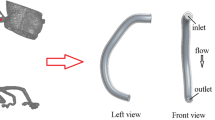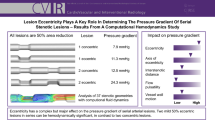Abstract
The present work analyzes the non-Newtonian nature of blood flow through a stenosed artery by utilizing the Rabinowitsch fluid model. We explored the pseudoplastic nature of Rabinowitsch fluid as the blood has the shear-thinning characteristic. The artery is affected by various shapes (bell shape, W shape, elliptical shape) and multiple stenoses. It has permeable wall and slip effects on the boundary. The governing equations of the flow are processed in dimensionless form along with the assumptions of mild stenosis and solved analytically. A detailed graphical analysis of the analytically attained solution is provided. It is found that the flow velocity gets higher values in the narrowed region, and it overgrows in the stenotic region. Its behavior depicted near the axis of the channel reverses in the vicinity of the arterial wall for slip parameter and Darcy number. The local sensitivity analysis is utilized to assess the influence of significant physical parameters on the flow velocity. The slip parameter has a more substantial impact, and stenosis height has a more negligible effect on the flow velocity. The Darcy number is more effective than stenosis height and less influential than the slip parameter. The streamlines split into the contours in the stenotic region close to the boundary. The size of contours diminishes for a quick flow and increases for growing stenosis height and higher Darcy number. These contours have various shapes depending upon the shape of stenosis.





















Similar content being viewed by others
Data availability
The data used to support the findings of this study are included within the article.
All the authors declare that our manuscript fulfills all ethical standards of research.
Abbreviations
- (\(\overline{r }, \overline{z }\)):
-
Cylindrical coordinates
- (\(\stackrel{-}{u,}\overline{w }\)):
-
Radial and axial velocities
- \(R (m)\) :
-
Non-stenotic radius of the artery
- \({d}_{l}\) \((m)\) :
-
Position of stenosis (\(l=\mathrm{1,2},3\))
- \({s}_{l}\) \((m)\) :
-
Width of stenosis (\(l=\mathrm{1,2},3\))
- \(m\) :
-
Parametric constant
- \(s (N{m}^{-2})\) :
-
Extra stress tensor
- α :
-
Slip parameter
- \({D}_{a}\) :
-
Darcy number
- \(\rho (kg {m}^{-3})\) :
-
Density
- \(\mu (Ns{m}^{-2})\) :
-
Dynamic viscosity
- \({\delta }_{l}^{*}\) (m):
-
Maximum height of stenosis in dimensional form
- PoI:
-
Parameter of interest
- \(k\) :
-
Non-linearity factor of the model
References
Srivastava VP, Vishnoi R, Medhavi A, Sinha P (2012) A suspension flow of blood through a bell-shaped stenosis. e-Journal of Science and Technology 7(1):97–107
Hisham MD, Awan AU, Shah NA, Tlili I (2020) Unsteady two-dimensional flow of pseudo-blood fluid in an arterial duct carrying stenosis. Physica A 550:124126
Sharma BK, Kumawat C, Makinde OD (2022) Hemodynamical analysis of MHD two phase blood flow through a curved permeable artery having variable viscosity with heat and mass transfer. Biomech Model Mechanobiol 1–29
Akbar NS, Nadeem S, Ali M (2011) Jeffrey fluid model for blood flow through a tapered artery with a stenosis. J Mech Med Biol 11(03):529–545
Akbar NS, Nadeem S, Lee C (2012) Influence of heat transfer and chemical reactions on Williamson fluid model for blood flow through a tapered artery with a stenosis. Asian J Chem 24(6):2433–2441
Akbar NS, Nadeem S (2014) Carreau fluid model for blood flow through a tapered artery with a stenosis. Ain Shams Eng J 5(4):1307–1316
Kumar H, Chandel RS, Kumar S, Kumar S (2014) A mathematical model for different shapes of stenosis and slip velocity at the wall through mild stenosis artery. Adv Appl Math Bio Sci 5(1):9–18
Ellahi RSUR, Rahman SU, Nadeem S, Vafai K (2015) The blood flow of Prandtl fluid through a tapered stenosed arteries in permeable walls with magnetic field. Commun Theor Phys 63(3):353
Srivastava N (2018) Herschel-Bulkley magnetized blood flow model for an inclined tapered artery for an accelerated body. J Sci Technol 10(1)
Prasad KM, Yasa PR (2020) Flow of non-Newtonian fluid through a permeable artery having non-uniform cross section with multiple stenosis. J Nav Archit Mar Eng 17(1):31–38
Akhtar S, McCash LB, Nadeem S, Saleem S, Issakhov A (2021) Mechanics of non-Newtonian blood flow in an artery having multiple stenosis and electroosmotic effects. Sci Prog 104(3):1–15
Tripathi B, Sharma BK (2021) Two-phase analysis of blood flow through a stenosed artery with the effects of chemical reaction and radiation. Ricerche di Matematica 1–27
Wada S, Hayashi H (1971) Hydrodynamic lubrication of journal bearings by pseudo-plastic lubricants: part 1, theoretical studies. Bulletin of JSME 14(69):268–278
Wada S, Hayashi H (1971) Hydrodynamic lubrication of journal bearings by pseudo-plastic lubricants: part 2, experimental studies. Bulletin of JSME 14(69):279–286
Singh BK, Singh UP (2014) Analysis of peristaltic flow in a tube: Rabinowitsch fluid model. Int J Fluids Eng 6(1):1–8
Sadaf H, Nadeem S (2017) Analysis of combined convective and viscous dissipation effects for peristaltic flow of Rabinowitsch fluid model. J Bionic Eng 14(1):182–190
Vaidya H, Rajashekhar C, Manjunatha G, Prasad KV (2019) Rheological properties and peristalsis of Rabinowitsch fluid through compliant porous walls in an inclined channel. J Nanofluids 8(5):970–979
Nadeem S, Qadeer S, Akhtar S, Almutairi S, Fuzhang W (2022) Mathematical model of convective heat transfer for peristaltic flow of Rabinowitsch fluid in a wavy rectangular duct with entropy generation. Phys Scr 97(6):065205
Akbar NS, Butt AW (2015) Heat transfer analysis of Rabinowitsch fluid flow due to metachronal wave of cilia. Results Phys 5:92–98
Khan AS, Shahzad A, Zubair M, Alvi A, Gul R (2021) Personalized 0D models of normal and stenosed carotid arteries. Comput Methods Programs Biomed 200:105888
Gul R, Shahzad A, Zubair M (2018) Application of 0D model of blood flow to study vessel abnormalities in the human systemic circulation: an in-silico study. Int J Biomath 11(08):1850106
Srivastava VP, Mishra S (2010) Non-Newtonian arterial blood flow through an overlapping stenosis. Appl Appl Math 5(1):17
Ahmed A, Nadeem S (2017) Effects of magnetohydrodynamics and hybrid nanoparticles on a micropolar fluid with 6-types of stenosis. Results Phys 7:4130–4139
Nadeem S, Akbar NS, Hendi AA, Hayat T (2011) Power law fluid model for blood flow through a tapered artery with a stenosis. Appl Math Comput 217(17):7108–7116
Akbar NS, Butt AW (2017) Entropy generation analysis in convective ferromagnetic nano blood flow through a composite stenosed arteries with permeable wall. Commun Theor Phys 67(5):554–560
Shahzad A, Khan WA, Gul R, Dayyan B, Zubair M (2021) Hydrodynamics and sensitivity analysis of a Williamson fluid in porous-walled wavy channel. CMC-Compurer Materials & Continua 68(3):3877–3893
Acknowledgements
The authors would like to thank the Deanship of Scientific Research at Umm Al-Qura University for supporting this work by Grant Code: 22UQU4330955DSR02.
Funding
No funding source is available for this research.
Author information
Authors and Affiliations
Contributions
All the authors have contributed equally. The authors read and approved the final manuscript.
Corresponding author
Ethics declarations
Conflict of interest
The authors declare no competing interests.
Additional information
Publisher's Note
Springer Nature remains neutral with regard to jurisdictional claims in published maps and institutional affiliations.
Rights and permissions
Springer Nature or its licensor holds exclusive rights to this article under a publishing agreement with the author(s) or other rightsholder(s); author self-archiving of the accepted manuscript version of this article is solely governed by the terms of such publishing agreement and applicable law.
About this article
Cite this article
Shahzad, M.H., Ahammad, N.A., Nadeem, S. et al. Sensitivity analysis for Rabinowitsch fluid flow based on permeable artery constricted with multiple stenosis of various shapes. Biomass Conv. Bioref. (2022). https://doi.org/10.1007/s13399-022-03311-5
Received:
Revised:
Accepted:
Published:
DOI: https://doi.org/10.1007/s13399-022-03311-5




